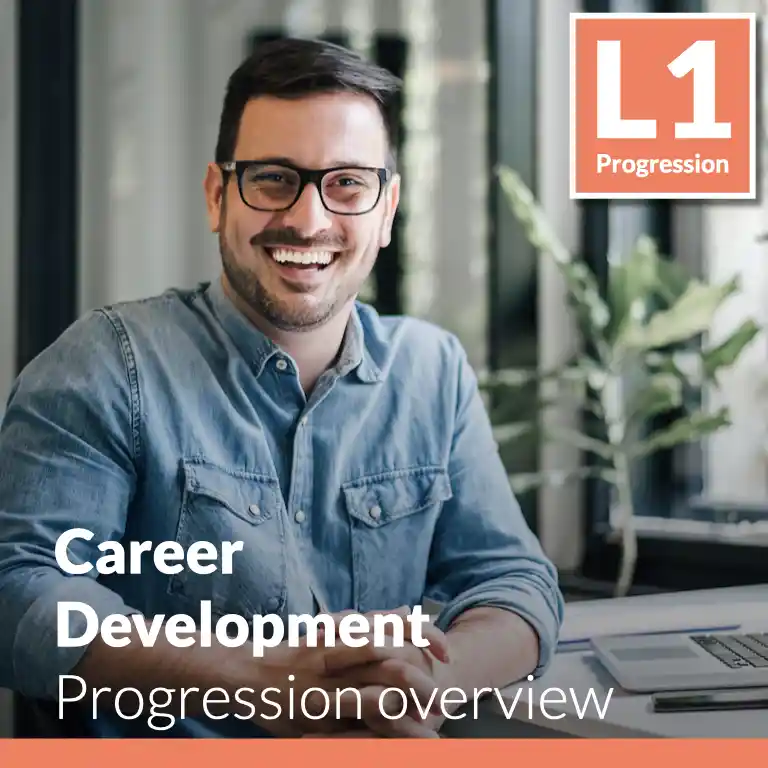Enjoy instant access to a scalable system of proven practices and execution-ready tools. Built to launch strategic HR programs 5X faster!
✓ Enjoy platform access
✓ Create your HR roadmap
✓ View open content in library
✓ Access dozens of practices:
⤷ The HR Strategy program
⤷ Explainers and deep dives
⤷ Supplemental guides
⤷ Insight articles
⤷ Weekly best practices
⤷ And more!
100% Free. No credit card required.
This guide is part of a progression set comprised of Core, Advanced, and Emerging Career Development practices.
Core Career Development is a process through which employee development is guided towards a targeted series of successive job roles that build upon one another and provide continued growth and challenge over the years. The guiding principle is leveraging employee skills and capabilities as they mature to align with strategic company growth plans and aspirations.
This level of sophistication involves defining success requirements and standards for every position to clarify and communicate the skills and experiences that drive high performance in each role and provide development guidance to employees who aspire to each position. It identifies the pathways between jobs and levels typically observed as employees interested in a particular career field can follow to best gain the experiences needed to move or advance from one to another. It creates a foundation for employees to self-assess their capabilities and gaps to generate development plans for particular career goals and objectives. Finally, it provides structured and formal guidance for creating development plans that guide employee selection of training and development activities tied to roles that consider not only their strengths and skills but also their professional ambitions and personal work preferences.
Career development is a partnership between the employee and the organization. The company provides direction and resources, and the employee acts on the motivation for increased challenges, responsibilities, and business impact. Such motivation is demonstrated in the continuous acquisition or enhancement of new and enhanced skills and capabilities that help build broader organizational capabilities.
A thoughtfully designed career development program creates a “win-win” scenario for the company and its employees. The company gains an ongoing supply of up-to-date technical and managerial skills, reduced employee turnover due to increased satisfaction with long-term career opportunities, and better skill gap management with more employees participating in learning and development activities. It creates a formal and structured pathway for consistently revitalizing talent pools that are available to meet the evolving needs of the business while providing continuous development of current and emerging skills.
From an employee perspective, seeing potential future job opportunities can reduce job burnout concerns and create a stronger desire to continue to advance with the company. The availability of development feeds the needs of motivated employees for growth and continues a drive to be recognized for one’s level of expertise and capability. It creates a view for all employees into the range of longer-term career opportunities and clarity related to what they need to achieve and develop to advance and grow within the organization. The acts of seeking out and completing personal and professional development also yield heightened loyalty and performance for the successful individual as growth is rewarded with new and often increased responsibilities. It provides a sense of movement and growth that feeds employee desires for a longer-term employment relationship with the company and an increased perception of fit and acceptance within the culture as an individual whose skills and capabilities continue to grow consistent with the organization’s evolution.
Adoption of these practices not only provides a clear roadmap for employees to create a longer-tenured career plan but also instills a sense of direction. Employees feel more focused and motivated in their career journey with objective guidance on achieving their aspirations. Clearly stated requirements and development guidance for each job in the organization go beyond the standard job description with greater detail into the types of experiences and learning that top performers in each role have accumulated. Both typical and idealized career paths provide guidance and a set of options for employees to build a portfolio of experiences through different types of jobs that can lead them to successful selection into a given role. They provide a process through which employees can compare their experiences and skills to those required by a particular role or set of roles to identify gaps that need to be filled by additional education, training, or experience. They create a formalized set of processes where employees can engage with their managers for career guidance and preparation. This results in a formal development plan tailored to the employee’s strengths, skill base, ambitions, and the opportunities that best map to those.
Identifying job success requirements for all positions to communicate what is needed to succeed in each job and what skills and experiences are required and preferred.
Identifying and documenting typical and idealized pathways between types and levels of roles.
Leveraging the intersection of success profiles and career paths for employee self-assessments of their education, experience, strengths, and skillsets against those outlined in the profiles.
Creating a formal plan for individual strengths, ambitions, and work preferences relative to company direction.

Enjoy instant access to a scalable system of proven practices and execution-ready tools. Built to launch strategic HR programs 5X faster!